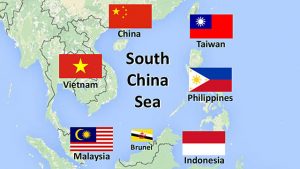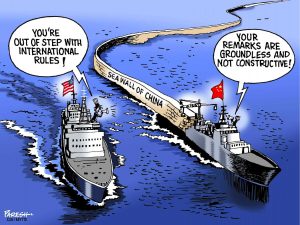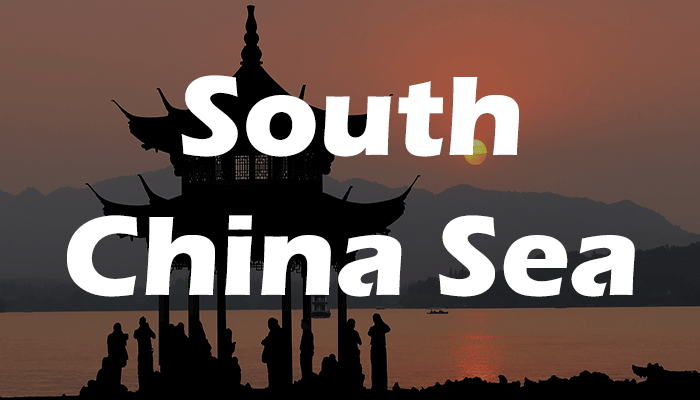In this article, we are here to discuss the in and out of the south china sea, which is already a burning issue for a while. Let’s dive in.
South China Sea Introduction
The South China Sea is a marginal sea that is part of the Pacific Ocean, encompassing an area from the Karimata and Malacca Straits to the Strait of Taiwan of around 3,500,000 square kilometers (1,400,000 sq mi).

The sea carries tremendous strategic importance: one-third of the world’s shipping passes through it carrying over $3 trillion in trade each year, it contains lucrative fisheries that are crucial for the food security of millions in Southeast Asia, and huge oil and gas reserves are believed to lie beneath its seabed.
The United States and China issue
The United States is demonstrating that China’s attempts to limit the rights and freedoms of navigation around portions of reclaimed land are outside the law and that the United States will continue to defend the rights of nations to navigate, fly over and operate in any place allowed by international law.

Although Chinese claims are still unclear, The Chinese military warned US aircraft to leave the area, claiming they were entering a “military alert area” even when they were flying more than 12 nautical miles from the portions of land occupied by China. International laws do not include the concept of “military alert area”.
The US destroyer that carried out the operation around the Subi Reef, the USS Lassen, also sailed near portions of land on the Spratly Islands occupied by Vietnam and the Philippines that have also had territorial claims, albeit on a much smaller scale. This was done to send the message that the purpose of FONOP was not to only point to China.
In addition to demonstrating the US willingness to challenge China’s attempts to restrict access or limit the legitimate navigation and overflight of the South China Sea.
The decision of the Obama Administration to initiate FONOP actions near the artificial islands of China is part of a strategy designed to modify China’s behavior and reassure the states of the region to guarantee that the United States will continue to be a key security element in the Asian Pacific.
Accepting more risks, Washington hopes to counteract the Chinese campaign of coercion and ensure that a stable and law-based order prevails.
Before starting to sail near the islands of China in the Spratly, the United States avoided risk behaviors and emphasized crisis management with China, what left the impression that Washington feared an escalation and did not have the will to face China.
But it is possible that the US side will take risks in the South China Sea carrying out frequent FONOP and other actions, although it will also seek confidence-building gestures with China to avoid accidents and reduce misunderstandings about each one’s intentions.
Peace maintenance in the South China Sea
Although some experts accused the United States of spoiling the operation by carrying out an “innocent step” that implicitly granted China territorial waters around the Subi Reef, which in its natural state is an elevation caused by low tide, this represents a misinterpretation of UNCLOS, the United Nations Convention on the Law of the Sea. Since the Subi Reef is located within 12 nautical miles of a rock also claimed by China, an uninhabited sandy key that is entitled to territorial waters according to article 13 of the UNCLOS, the Subi Reef can be used as a reference point to measure the territorial waters of that other piece of land. Thus,
If the Mischief Reef, which is not located within 12 nautical miles of another piece of land, had been chosen, a US Navy vessel would have been asked to carry out a non-innocent freedom of navigation operation that included military activity, such as the deployment of helicopters or the collection of information through navigation with fire control radars turned on.
Why Everyone’ wants the South China Sea?
- Six countries have different claims on this region where approximately 30 percent of the world’s maritime trade passes, merchandise valued at $ 5 trillion annually; and in which, in addition, there are rich reserves of gas and oil.
- In the 19th century, countries fought over control of the Strait of Gibraltar or the Suez Canal, nowadays it is the pass of Malacca and the South China Sea, that’s why Singapore is such a rich country, it is much more important in economic terms; So, if China wants to control world trade, it has to control the South China Sea.
- According to the researcher, it is the most important maritime commercial transit route in the world. It is key to have control of the trade that moves by boat.
- There is no evidence that China has historically exercised exclusive control over water or its resources
- China claims the jurisdiction of seven islets/reefs, including the Spratly and Paracel, key passages of maritime trade.
- The resolution of the court determined that these formations do not meet the legal requirements of an island so they can not belong to China. According to the ruling, when claiming these islets, Beijing is claiming international waters, since the Law of the Sea Commission dictates that the Exclusive Economic Zone is 200 nautical miles.
- The Chinese government considers these islets a national priority and in recent years has intensified its activity in them.
- In his case, the Philippines complained about the damage done to the reefs, the construction on them, as well as indiscriminate fishing.
- Since the court opened the case in 2013, China indicated that it did not recognize the jurisdiction of the court in this case and rejected the ruling after the ruling. And while the court says the ruling is binding, it lacks a mechanism to apply it.
- The deployment of defensive weapons by China in these islands occurs after the Asian giant also installed military blocking equipment, which disrupts the communications systems and radars of any ship or plane that, without authorization from China.
- China has built military facilities four times the size of Buckingham Palace on disputed islands of the South China Sea, according to a new report that points to the escalation of a “slow crisis” in one of the most unstable hotbeds of tension in the world.
- China claims almost all of the sea and has artificially increased the size of some islands, where it has deployed a series of warplanes to reinforce its right.

